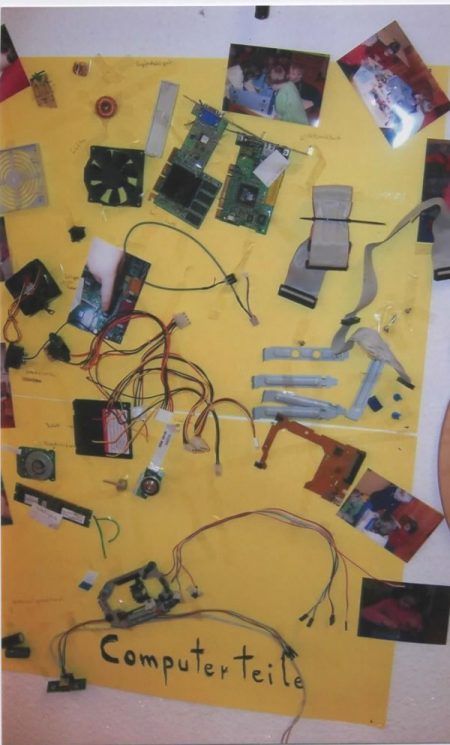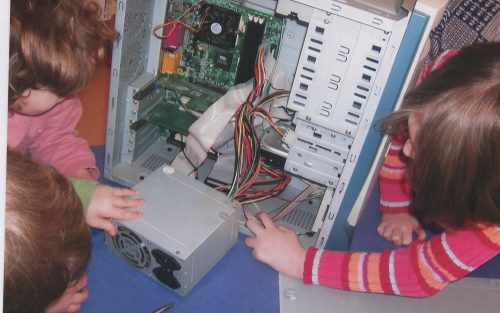by Claudia Flaig
A cross-group technology project ran for 12 weeks in our kindergarten. For organisational reasons, it took place for one hour in the morning on two days of the week.
At the beginning of the project, we put up a poster asking parents to donate their old electrical appliances. Within a few days, we receive two computers, a video recorder, a bathroom scale and a CD player with speakers. Later, more equipment is added.
A computer is taken apart
First, I put the computer and a toolbox on a table in the project area – a kindergarten hallway where free play is otherwise offered and some of the children have lunch.
As soon as the children come to the kindergarten, they rush to this table with interest. Alena, my observation child in the IHVO Certificate Course, has been coming extra early since then. Children from all groups, including the U3 (children under three years), want to „screw“.
We stick the dismantled small parts on a poster. The parents – especially the fathers – show interest and are then included as experts.

Next to the glued-on computer parts I write – as far as I know – the exact names. A father takes a photo of a part I don’t know. He finds out that it is an obsolete floppy disk drive. And he also brings along a floppy disk so that we can follow the technical procedure.
It takes the children six hours
to dismantle the first computer.
My help only consists of explaining how to use tools safely, getting technical literature and loosening the screws.
Sometimes the children take small parts with them and ask their grandpa or uncle what it’s all about.
In the meantime, the children only need one and a half hours to dismantle a computer. „Violence“ is only used on solder joints.
What the children can learn
The children learn that different activities are required to assemble a device: They screw, glue, plug, solder, melt and staple.
Familiar individual parts appear again and again: Drives, magnets, spirals, springs, gears of various sizes.

The process of disassembling always requires that the respective object part be fixed precisely. The screwdriver (sometimes slotted, sometimes cross-slotted) is pressed and then turned to the left. The last turns are made with the fingers so that we can put the screw into the material bowl. After discovering magnetism through the magnets in the speaker boxes, magnets are also used to secure screws that have been turned out.
The children quickly find out that it is helpful to turn the object to be taken apart. This way, they can always discover new ways to get screws or plugs.

Even these basic skills mentioned above mean a challenge for many children and make for a beaming smile after they have successfully mastered them.
For other, particularly interested, especially gifted children, the „adventure of technology“ only begins here!
The discovery of magnetism leads us to experiment with magnets. We get the book „What is what? Magnetism“ and browse through it a lot. The topic also fits in with the poster about the routes of migratory birds that hangs in the hallway. An old familiar magnet construction game takes on a whole new meaning!
See also: Experiments with Magnets
Clear rules for safety
Many rules that are necessary for safety when dismantling equipment „come naturally“ and are quickly learned by children.
Here are the most important ones:
-
- Never put removed plugs into the socket! (I dispose of them immediately).
- Always work away from the body with tools – risk of injury!
- We take turns – but each mechanic is allowed to finish his job in peace!
- We try to use as little force as possible. By turning the object, we are sure to find new ways of dismantling it.
- Most cable ends have a plug at the end. We only cut cables in an emergency. Our expert is the „computer expert“ Mariana (5 years old). We can ask her – she finds every plug!
- Small parts that fall on the floor have to be picked up immediately – baby alarm!
The disassembly project has proven itself
In the meantime, dismantling electrical appliances has become a regular part of free play.

We still have some appliances „in stock“. In addition, Amar (5 years old) has suggested building a computer man out of the scrap parts – a great idea!
Alena shows great interest in the project. However, she never works on the equipment alone for long. She especially likes to work in a team.

Date of publication in German: April 2018
Copyright © Hanna Vock, see imprint
